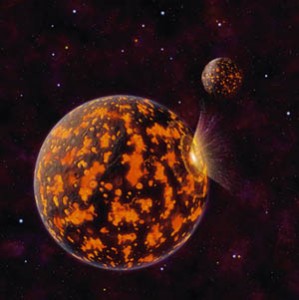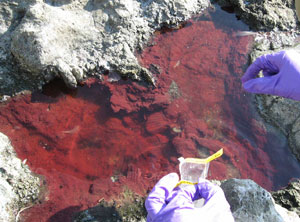Searching for Life on Earth
But if you know what life is worth, You will look for yours on Earth -- Bob Marley
– “Is there life on Earth?”
– “Well, duh.”
– “I mean, is there another kind of life on Earth?”
– “WTF?”
– “You know… there could be these bugs that, like, they’re all around us and we don’t know they are there because that’s not the life we recognize”.
– “Whoa, dude, hea-vy”
Actually, this conversation may not be as sophomoric or THC-laced as I made it out to be. OK, OK. obviously it is sophomoric and THC-laced, but I put a quote from Marley not for the cannabis allusion, but for the literal interpretation: looking for Life on Earth.
– “Seriously dude, WTF?”
Could life have arisen on Earth more than once? If so, can we find evidence of this happening? Even more so: could this “weird life” still exist here undiscovered?
Did life happen more that once?
The definition of life is an elusive one. We can all agree that humans are alive. Rocks are not. Viruses? A bit iffy: they reproduce, and they rely on life’s machinery to reproduce, but they lack autonomous reproductive ability. Is DNA alive? No. It facilitates life, but it is not alive in itself. The border is a slightly fuzzy (known contentious cases include viruses, prions and stoned college students), but we can all agree on the identities of most of the inhabitants on either side of the life / non-life border.
It is clear that Earth was once all non-life. We can also agree that it is now teeming with life. At some point in its history life has emerged from non-life ingredients, by a process
still unknown. But could that process have occurred more than once? There are four possible answers:
1) No, life only arose once on Earth, all life on Earth is descended from a Last Universal Common Ancestor (LUCA).
2) Yes, life arose more than once, but was eradicated without a trace, either by known life or by early impact activity on Earth. In fact, life may have arisen and annihilated several times. Still, all extant life on Earth is descended from a LUCA.
3) Yes, life arose more than once. Extant life is descended from a LUCA, weird life is not around anymore, but traces of it can be found.
4) Yes, life arose more than once, and weird life does exist on Earth, but we have not found it yet.
Let us not dwell too much on scenarios (1) or (2), because there is not much we can do with those scenarios: if all life on Earth is descended from a LUCA, and there are no traces of another common ancestor, our search for weird life on Earth — be it extinct or extant — grinds to a halt. Whatever the reason, the evidence for weird life is not there.
Scenario number 3 is interesting: weird life arose on (or was delivered to) Earth more than once, and this event or these events left traces. For starters, we can safely assume life did not spontaneously arise as pink elephants (despite what our good friends from the dialogue above may be experiencing), but rather in some microbial form. If life arose and then went extinct during the great impact period, we may find traces of it on the Moon or on Mars in Earth ejecta from that period. We may also find microfossils in rocks >3.5 billion years ago (Gya) here on Earth itself. The trouble is, if weird microbes were be similar in shape to regular microbes, we may not be able to distinguish their microfossils from non-weird microfossils. However, if such microfossils were to be dated considerably earlier than 3.5 Gya, then life on Earth is probably much older than we thought, and we need to add yet another mass extinction, probably a sterilizing one, to the known Big Five.
On the other hand, if weird life microfossils are too different from known microfossils, we may not be able to recognize them for what they are. It is also hard to imagine a finding — other than pink elephant bones fossilized >3.5 Gya —
that would not be open to heavy dispute. To date, no such finding has been reported. The finding of possible Martian microfossils on meteorite ALH54001 in 1996 — and the ensuing controversy– can hint at the problems with validating ancient terrestrial microfossils.
They are here
The fourth possibility is the most intriguing: weird life is here, and it may very well be hidden. It can be hidden in Earth’s most extreme environments where it does not have to compete with regular Earth life for resources; or it may be hidden in plain sight, with a biochemistry so foreign that it is not detectable by the means we currently employ. Also, it’s a safe assumption that extant weird life is microbial, with all due respect to pink elephants.
One idea that has been proposed was Arsenic based life. Arsenic (As) is an element that is chemically similar to Phosphorous (P). Phosphorous is essential to life in many aspects: a constitute in the backbone of RNA and DNA, a component of enzyme cofactors and as an informational and energy unit in the cell. In fact, Arsenic’s toxicity is due to its similarity to Phosphorous: by competing with phosphate (PO43-) in mitochondria, Arsenate (AsO43-) prevents the formation of ATP, blocking respiration.
Since 1994 it has been known that As(III) is used by some eubacteria as an electron acceptor in respiration of some bacteria. Recently, bacteria inhabiting the alkaline shores of Mono Lake, California were found to be using Arsenic(III) as an electron donor in photosynthesis. It is not inconceivable that Arsenic, in some form, may be have been
used as a Phosphorous replacement, although the latter, much more fundamental biochemical change, has not been found yet; not even in the Mono Lake bacteria.
Weird life on Earth, or on other planets, is yet to be discovered. If weird life does exist on Earth, and there is a non-LUCA parallel biosphere, that would not only revolutionize life science, but alert us to a very important principle: generating life is a commonplace happening, and would increase the probability that we are not alone in the universe.
Felisa Wolfe-Simon, Paul C.W. Davies, Ariel D. Anbar (2009). Did nature also choose arsenic? International Journal of Astrobiology DOI: 10.1017/S1473550408004394
P.C.W. Davies, Charles H. Lineweaver (2005). Finding a Second Sample of Life on Earth Astrobiology, 5 (2), 154-163 DOI: 10.1089/ast.2005.5.154
Paul Davies (2007). Are aliens among us? Scientific American, 297 (6), 36-43 DOI: 18237098
T. R. Kulp, S. E. Hoeft, M. Asao, M. T. Madigan, J. T. Hollibaugh, J. C. Fisher, J. F. Stolz, C. W. Culbertson, L. G. Miller, R. S. Oremland (2008). Arsenic(III) Fuels Anoxygenic Photosynthesis in Hot Spring Biofilms from Mono Lake, California Science, 321 (5891), 967-970 DOI: 10.1126/science.1160799























I read about this the other day – your post is a really great synthesis of the ideas.
Very well written!
You omitted the possibility that 4b) We haven’t realized that some life is not all from a LUCA. There are several recognized mergings between different creatures which are thought to have a LUCA. There could be known life forms which include non-LUCA components.
I know it’s unlikely that known life forms are not from our LUCA. Standard classification methods identify enough known characteristics that it is unlikely that known organisms are not from out LUCA. And there has been speculation that non-LUCA organisms might have trouble digesting those from our LUCA, but with all this potential food around I find it hard to believe that anything on our planet which lives on the surface wouldn’t be evolving to nibble on our convenient bags of dirty water.
Irradiatus: thanks 🙂
MarkSense: not sure what you mean. The basic biochemistry of heredity: DNA, RNA Protein is common to all life, and “marginal life” (viruses). We need a serious departure from this to suggest a shadow biosphere. Weird life may exist, but as alluded to by your post, not on the surface, where known life has probably subsumed everything. Weird life may exist in the extreme and primordial conditions of the deep sea vents in the Atlantic ridge, or in oil drillings kilometers deep.